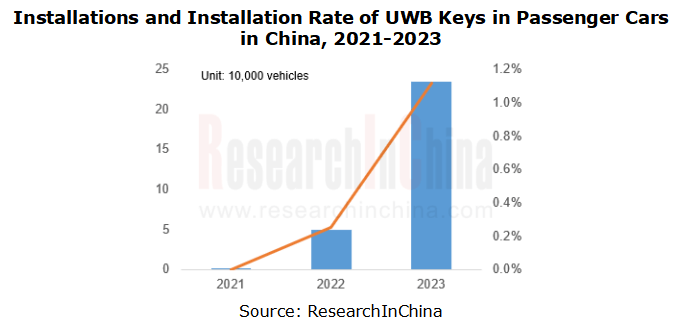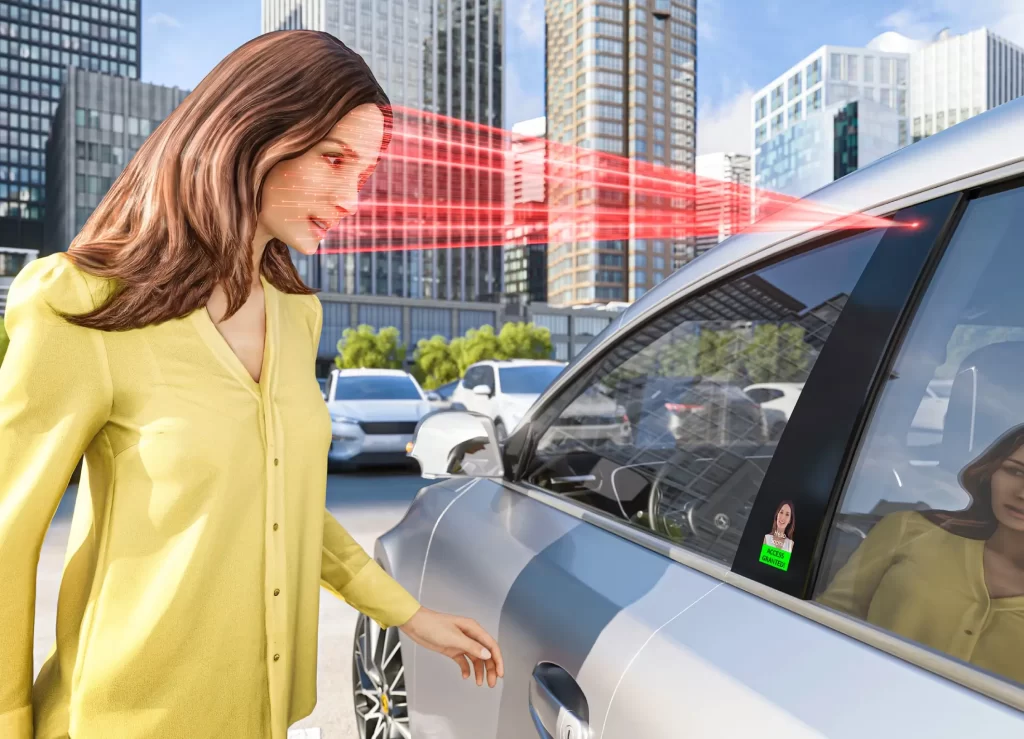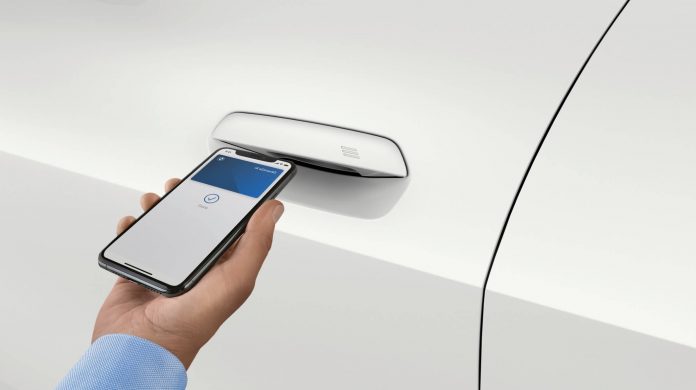1. Digital keys enter the UWB era
In recent three years, the Chinese automotive digital key market has been burgeoning, with the installation rate increasing by more than 10 percentage points every year. In 2023, the installations of digital keys in passenger cars in China surged by 53.0% year on year; the installation rate jumped by 10.2 percentage points on the previous year to 33.0%.
In terms of technology route, UWB has become a “starlet” in the field of digital keys after BLE and NFC got on vehicles. In 2023, UWB digital keys were largely seen in passenger cars in China, with installations rocketing by 371.4% on an annual basis and the installation rate up to 1.1%, much higher than in the previous year.

In 2023, 14 auto brands (NIO, Denza, ZEEKR, Lynk & Co, BMW, Toyota, BYD, Xpeng, AITO, etc.) used UWB keys, compared with only 3 brands (NIO, Denza and HiPhi) in 2022. Among the popular models launched in the last six months, Xpeng X9, AITO M9, ZEEKR 007 and Yangwang U8 are all equipped with UWB keys.

Also auto brands are installing UWB keys in more vehicles. For example, almost all NIO’s new models are equipped with UWB keys as standard; Denza D9 Flagship/N7/N8 and ZEEKR 007/009/X all feature UWB keys. In addition, OEMs are working hard on the plan of making UWB keys available in vehicles, increasing the market demand:
- Tesla APP now supports the ultra-wideband (UWB) key in the 2024.2.3 version of the APP for iPhones.
- BYD UWB digital keys have been installed in Han EV Qianshancui, Tang DM-p Ares Edition, Denza N7, Yangwang U8 and other models, and will be seen in Sea Lion 07 and Leopard 5 among others in the future.
- In March 2024, Lynk & Co 08 EM-P started the beta test of the 1.3.0 version of Flyme Auto, and added the UWB key in Meizu mobile phones. In addition, Lynk & Co 08 EM-P is adapting to the UWB function of iPhone, which will be available to subsequent editions.
2. UWB adds functions such as vehicle search and APA to digital keys.
With the increasing number of components such as sensors and communication modules in vehicles, system integration and functional scalability have become the ways to help OEMs reduce costs and improve efficiency. In addition to replacing conventional keys, digital keys are being integrated with such functions as remote vehicle control, in-cabin monitoring, and APA.
Based on the characteristics of high-precision positioning, UWB can add vehicle search, APA and other functions to digital keys. For example, Meizu mobile phones can leverage UWB to automatically record vehicle locations, guide users to search cars, and find cars even without network.
Automatic record: The vehicle can automatically record the parking environment after being engaged in the P gear, and upload key information such as the parking floor, parking space number and parking duration to the user’s mobile phone through Flyme Link.
Vehicle search guide: There is no need to backtrack. The optimal search route is planned through spatial positioning, and cross-floor search is supported. All sensors of IVI and the mobile phone, coupled with spatial positioning algorithms, accurately spot the vehicle. The direction, distance and floor information of the vehicle can be presented intuitively on the functional components of the mobile phone, providing a guide to find the vehicle.
Vehicle search without network: In a parking lot without network or GPS signal, the mobile phone can automatically switch to the unconnected navigation mode, and guide the way through spatial positioning to find where the vehicle is parked.
Lynk & Co 08 EM-P is the first model installed with Flyme Auto, featuring Meizu’s vehicle search function.
3. Compatibility is the bottleneck that digital keys need to break urgently.
As the entrance to vehicle intelligence, digital keys need to solve the compatibility problems in multiple aspects: compatibility between software and hardware modules, e.g., BLE, NFC, UWB and NearLink; compatibility between standards of different alliances, e.g., CCC and ICCE; compatibility between communication protocols between cars and mobile phones of different brands.
Standard compatibility between alliances is being improved.
- In November 2023, FiRa and the CCC formed the Joint Ultra-wideband MAC PHY Working Group (JUMPWG) aimed at developing and maintaining the UWB technology specifications used in the CCC Digital Key. CCC members include most OEMs, while FiRa members include most mobile phone or consumer electronics vendors. The partnership will promote the integration of UWB standards between the two parties and encourage the application of UWB technology at vehicles.
- NearLink, the next-generation short-range wireless connection technology led by Huawei, can be compatible with Bluetooth and WiFi ecosystems and interoperate with existing devices. In the future, following SLB (a benchmark for WiFi) and SLE (a benchmark for Bluetooth), NearLink will launch SLP (a benchmark for UWB) to integrate more communication standards.
Two paths for OEMs to break through protocol barriers.
Communication compatibility between vehicles and mobile phones of different brands is particularly important in key sharing scenarios. NIO and BYD represent two different paths.
- To circumvent Apple’s protocol restrictions, NIO has developed its own NIO Phone. In addition, Geely Meizu, Huawei HarmonyOS, Xiaomi and other OEMs engaged in mobile phones will follow suit and take the lead in the deep integration of IVI and mobile phones in the same system.
- BYD was certified by Car Key MFI in 2022, becoming China’s first brand that is compatible with both Android and Apple systems. At present, BYD’s NFC digital keys are compatible with all mainstream mobile phone brands, including Huawei, Apple, Xiaomi, OPPO, VIVO, OnePlus and HONOR. This will be the path taken by most OEMs (including foreign brands). BMW’s digital keys not only cover iOS platforms but also become available on Android platforms. Since November 2022, BMW’s digital keys have gradually spread to Huawei, HONOR, Xiaomi, vivo and OPPO.

Suppliers integrate software and hardware.
The integration of software and hardware aim to solve such problems as software and hardware from different suppliers, unsmooth system connection and inefficient OTA updates. INGEEK believes that the integration of software and hardware is a reliable solution, and hopes to redefine chips, connections and cloud products and enhance product experience.
INGEEK’s latest Intelligent Connection System (ICS) is composed of an ecosystem connection platform (DK HUB), a software and hardware integrated system (DK System) and a tool kit (DK Toolkit), realizing mass production of software-hardware integration. In 2023, INGEEK secured software-hardware integration OEM mass production projects from four or five OEMs, and supported Dongfeng Voyah at first.
In April 2023, INGEEK and Tencent Intelligent Mobility jointly launched the “Digital Key Cloud”. Through the standardized digital key products and services, it can save a lot of time and deployment costs required for individually customized solutions, and solve the problem of difficult cooperation between cars, cloud, Apps and more when installing digital keys in different models.

4. Biometrics is expected to be a supplement to digital keys to build next-generation automotive intelligent entry systems.
Biometrics is joining automotive intelligent entry systems. Palmprint and face recognition prevails in the application cases of OEMs and suppliers, especially in unconscious entry and unconscious startup.
BYD released a palm key in January 2024, allowing users to unlock vehicles through palmprint recognition. This marks BYD’s foray into the biometric key field to build all-scenario intelligent entry experience.
At CES 2024, Continental presented the “Face Authentication Display”, a two-stage access control system based on biometric user recognition that uses special camera systems mounted externally on the vehicle’s B-pillar and invisibly behind the driver display console. Thanks to biometric face authentication, the vehicle opens and starts up as soon as it detects a registered user.

Off-vehicle application of Continental Face Authentication Display: Advanced facial authentication technology, which Continental integrates into the vehicle’s B-pillar, makes it possible to open the driver’s door without a key or other means of access.
Even if biometrics comes into the market, digital keys will still be the protagonist in the next 5-10 years. This is mainly because mobile phones play a leading role in consumers’ daily lives and collect most of users’ data and information. The integration of mobile phones and IVI is a megatrend. Mobile phones, as the carrier of digital keys, have enormous potential. In the next stage of automotive intelligent entry systems, biometrics is expected to complement digital keys to build next-generation automotive intelligent access systems.

